Strict-Transport-Security
語法
Strict-Transport-Security: max-age=<seconds>
Strict-Transport-Security: max-age=<seconds>; includeSubDomains
Strict-Transport-Security: max-age=<seconds>; includeSubDomains; preload
NodeJS HTTP Server
根據 MDN 文件 的描述:
Note: The host must send the Strict-Transport-Security header over HTTPS only, not insecure HTTP. Browsers ignore the header if sent over HTTP to prevent a manipulator-in-the-middle (MITM) from altering the header to expire prematurely or adding it for a host that doesn't support HTTPS.
在 HTTP Protocol 的情況設定,browser 會忽略,那我們就架一個 NodeJS HTTP Server 試試看!
index.ts
import httpServer from "../httpServer";
httpServer.removeAllListeners("request");
httpServer.on("request", function requestListener(req, res) {
res.setHeader(
"Strict-Transport-Security",
"max-age=31536000; includeSubDomains",
);
res.end();
return;
});
使用瀏覽器打開 http://localhost:5000/
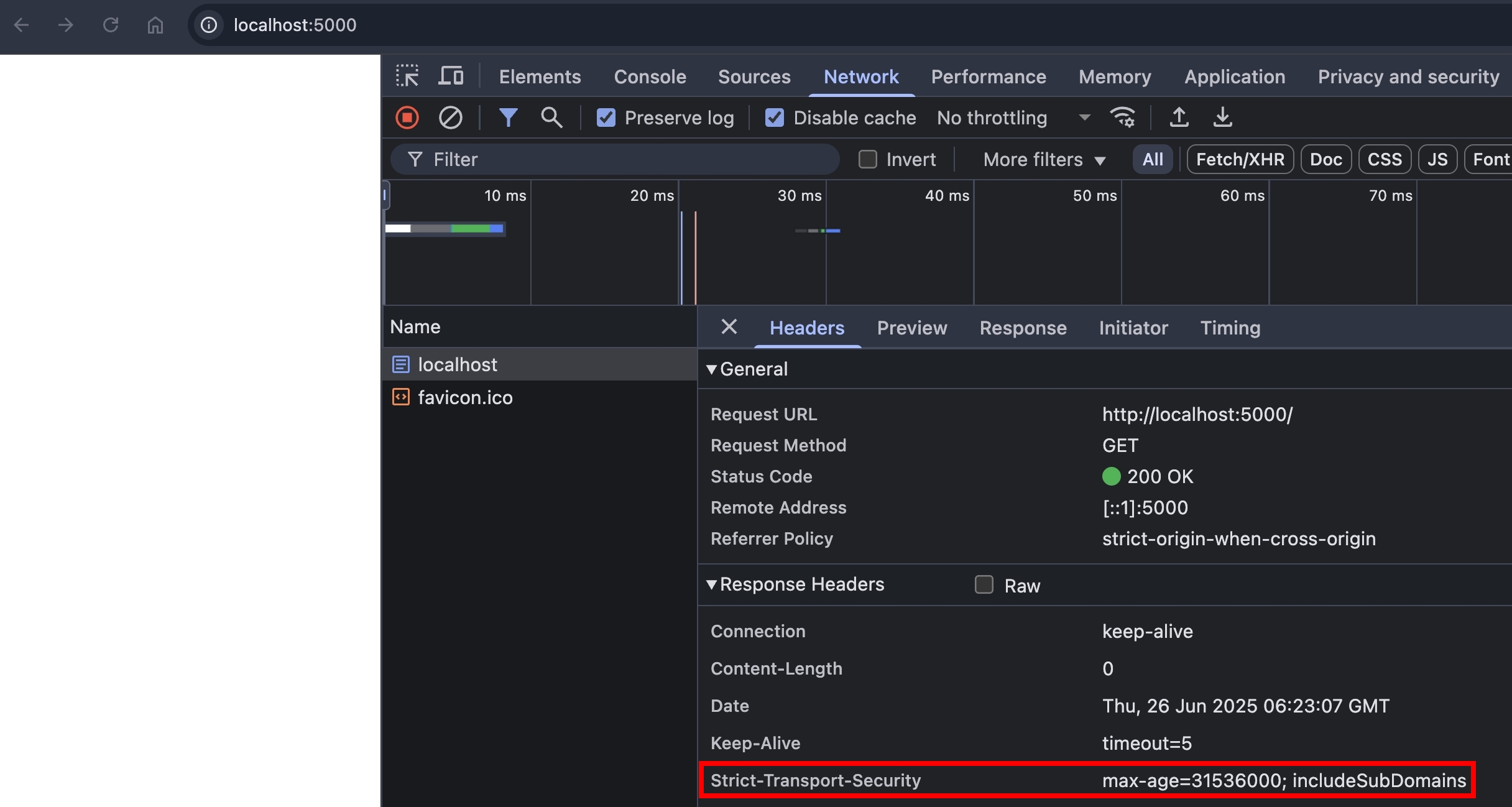 恩...沒有跳任何 warning message,那我們要怎麼驗證呢?Chrome 有提供一個頁面可以查詢 HSTS(HTTP Strict Transport Security),輸入
恩...沒有跳任何 warning message,那我們要怎麼驗證呢?Chrome 有提供一個頁面可以查詢 HSTS(HTTP Strict Transport Security),輸入 localhost 以及 localhost:5000 查詢看看~

 都沒查到!代表 Chrome 真的忽略了在 HTTP Protocol 設定的 HSTS(但我們還需要驗證在 HTTPS Protocol 是否就會紀錄 HSTS)
都沒查到!代表 Chrome 真的忽略了在 HTTP Protocol 設定的 HSTS(但我們還需要驗證在 HTTPS Protocol 是否就會紀錄 HSTS)
NodeJS HTTPS Server
我們按照以下步驟,在本機啟動 NodeJS HTTPS Server
private-key.pem & cert.pem
# 產生私鑰
openssl genrsa -out private-key.pem 2048
# 產生自簽憑證
openssl req -new -x509 -key private-key.pem -out cert.pem -days 365
httpsServer.ts
import { readFileSync } from "fs";
import { createServer } from "https";
import { join } from "path";
const httpsServer = createServer().listen(5001);
httpsServer.setSecureContext({
key: readFileSync(join(__dirname, "private-key.pem")),
cert: readFileSync(join(__dirname, "cert.pem")),
});
export default httpsServer;
index.ts
import httpsServer from "../https-server/httpsServer";
httpsServer.removeAllListeners("request");
httpsServer.on("request", function httpsRequestListener(req, res) {
res.setHeader(
"Strict-Transport-Security",
"max-age=31536000; includeSubDomains",
);
res.end();
return;
});
使用瀏覽器打開 https://localhost:5001/
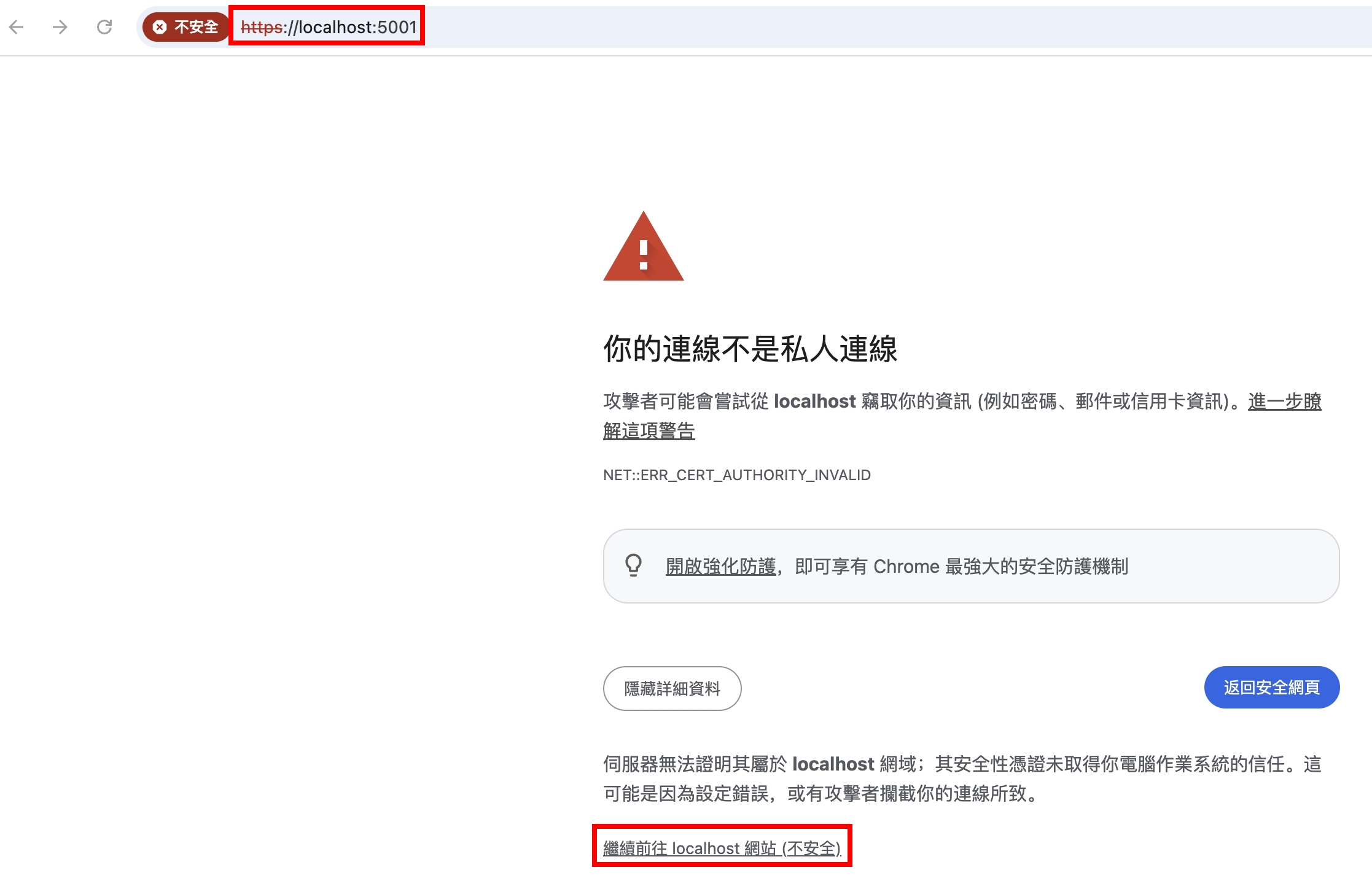 恩...看來遇到了自簽憑證不被信任的問題,此時瀏覽器也不會註冊 HSTS
恩...看來遇到了自簽憑證不被信任的問題,此時瀏覽器也不會註冊 HSTS
mkcert 建立本機 CA
我們把剛才生成的 private-key.pem 跟 cert.pem 砍掉,並且執行
brew install mkcert
brew install nss # to work on firefox
mkcert -install
mkcert -key-file private-key.pem -cert-file cert.pem localhost
然後重啟 NodeJS HTTPS Server,關閉瀏覽器,並且重開
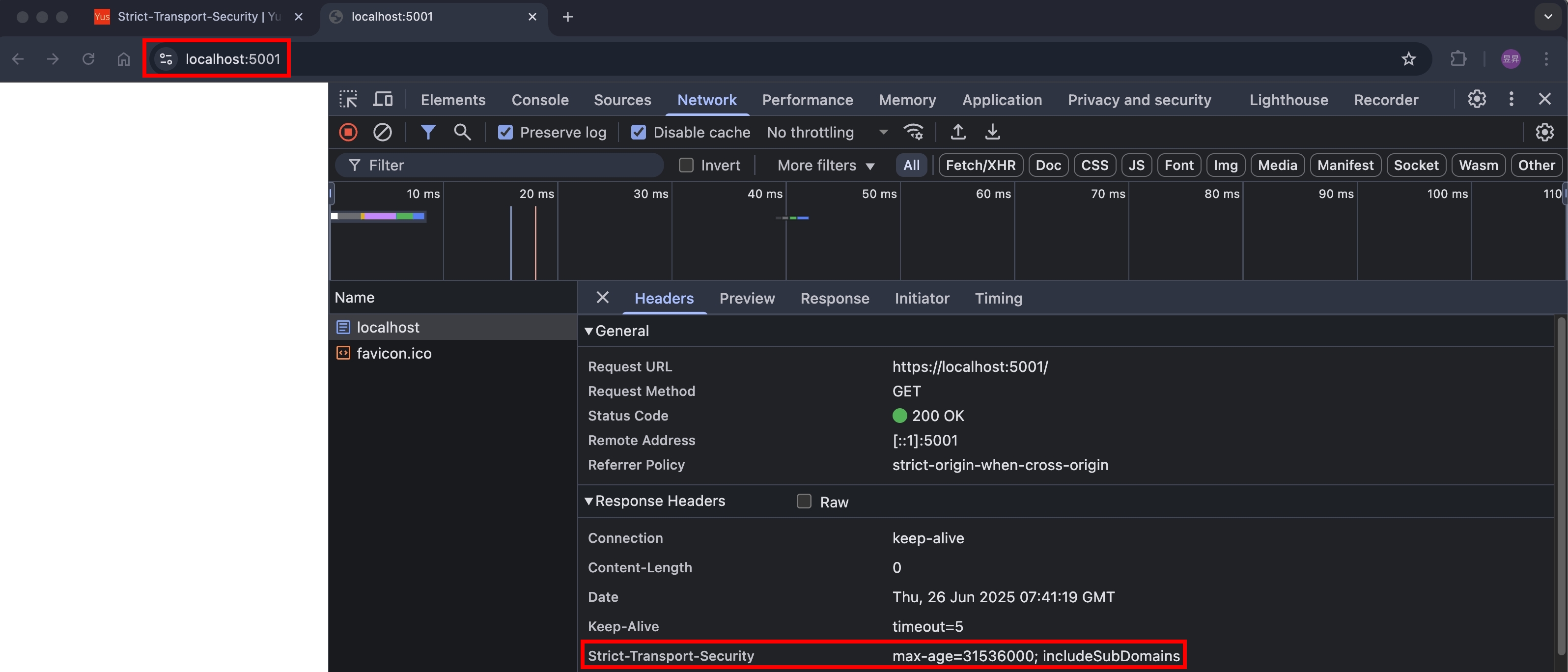 這次沒有跳警告了,我們用 chrome://net-internals/#hsts 查查看
這次沒有跳警告了,我們用 chrome://net-internals/#hsts 查查看

 還是沒有!我推測有幾種可能性:
還是沒有!我推測有幾種可能性:
- 瀏覽器不會紀錄 localhost 這個 host
- chrome://net-internals/#hsts 不會立即查到剛設定的 Strict-Transport-Security
設定 hosts 檔案
為了逐步排查,我們先來設定本機的 hosts 檔案
127.0.0.1 hsts.test.com
127.0.0.1 nodejs.hsts.test.com
127.0.0.1 sub.nodejs.hsts.test.com
然後記得把剛才生成的 private-key.pem 跟 cert.pem 砍掉,然後重新簽憑證
mkcert -key-file private-key.pem -cert-file cert.pem hsts.test.com nodejs.hsts.test.com sub.nodejs.hsts.test.com
把瀏覽器關掉重開,輸入 https://hsts.test.com:5001
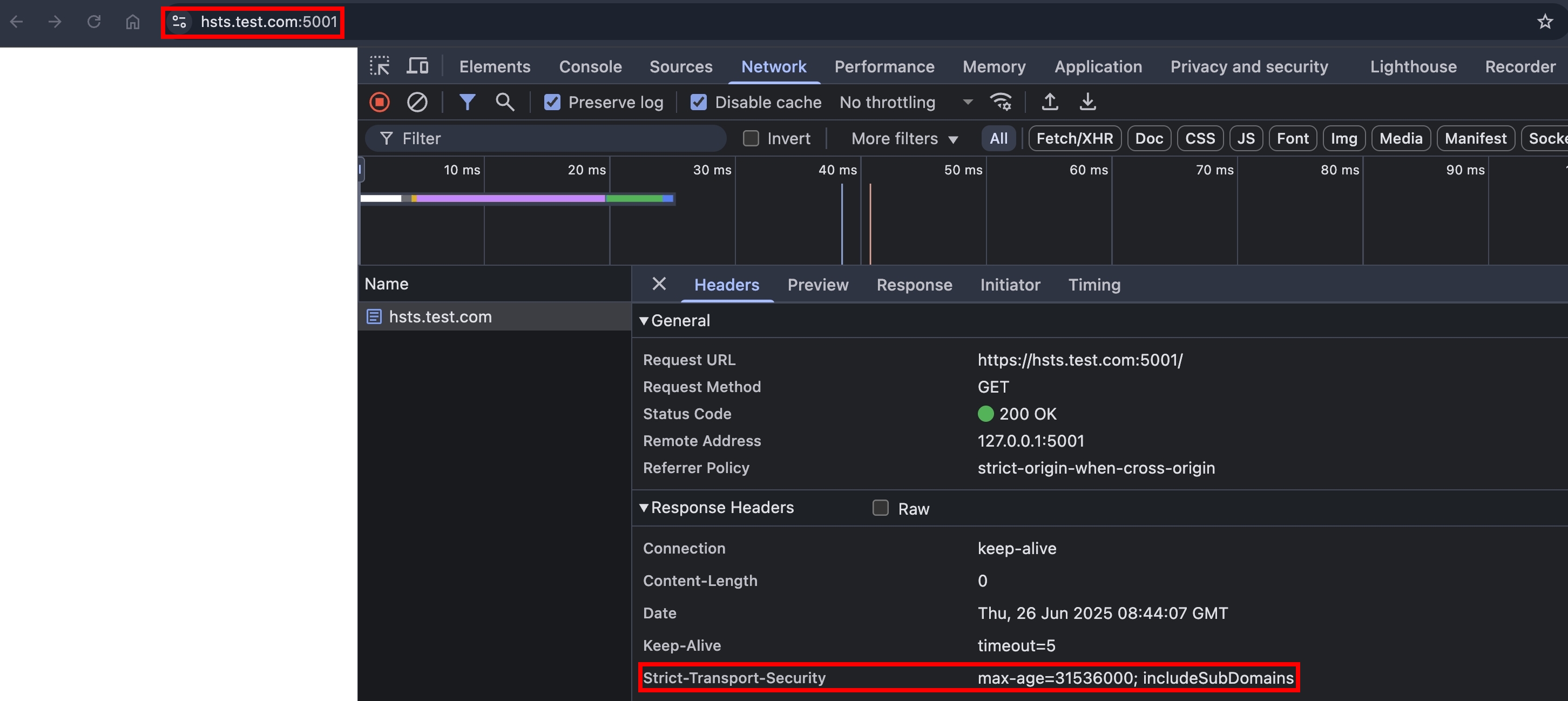
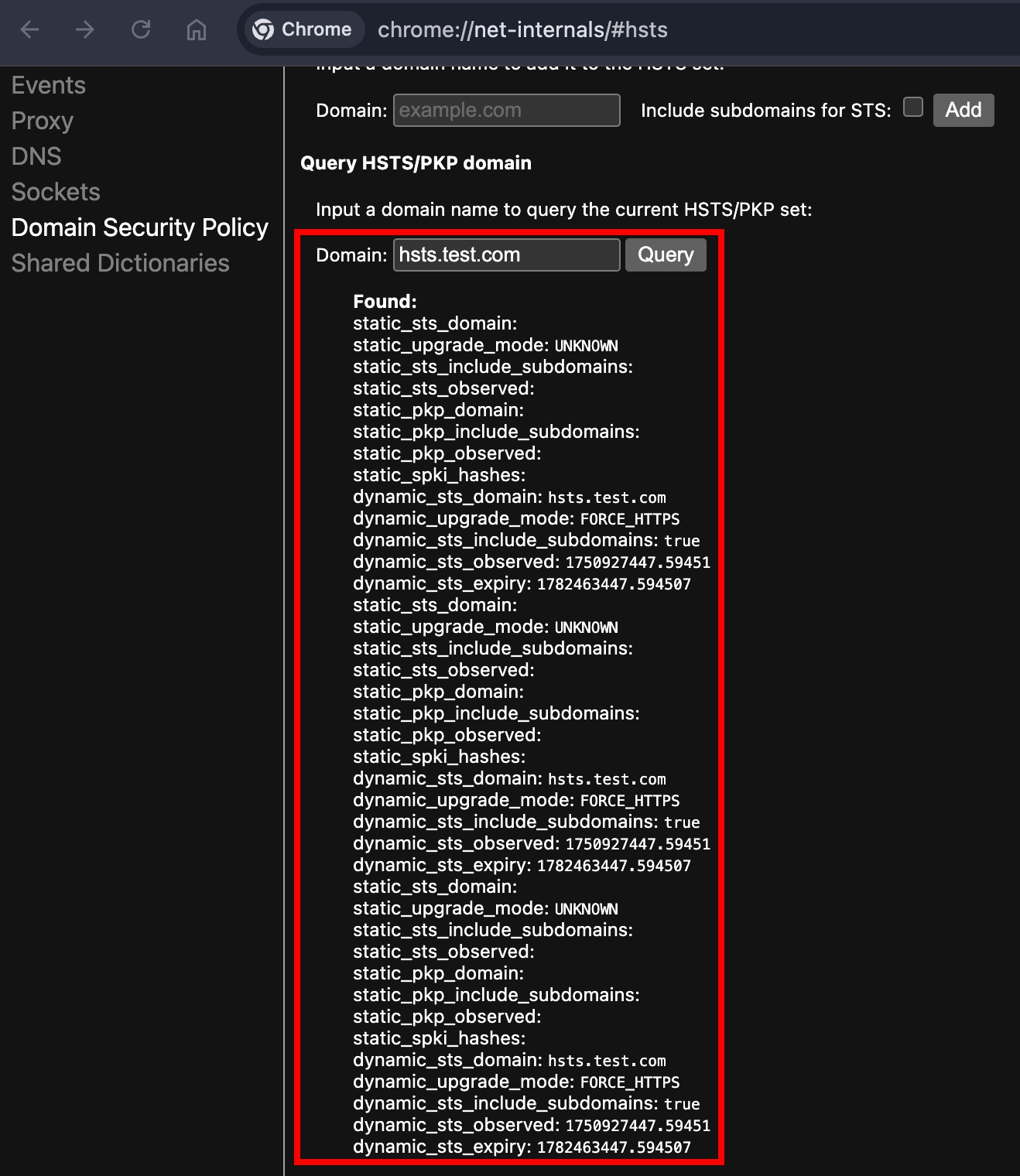 成功在 Chrome 註冊 HSTS,並且查得到了!看來我上面的猜測是正確的
成功在 Chrome 註冊 HSTS,並且查得到了!看來我上面的猜測是正確的
憑證不安全的情境
根據 MDN 文件 的描述:
If a TLS warning or error, such as an invalid certificate, occurs when connecting to an HSTS host, the browser does not offer the user a way to proceed or "click through" the error message, which would compromise the intention of strict security.
好的,那我們現在就來把憑證變成不安全,把剛才生成的 private-key.pem 跟 cert.pem 砍掉,然後重新簽憑證
mkcert -key-file private-key.pem -cert-file cert.pem localhost
由於剛剛瀏覽器已經把 hsts.test.com 記在 HSTS 列表了,這時候憑證變成不安全,理論上不會讓我們訪問 https://hsts.test.com:5001/
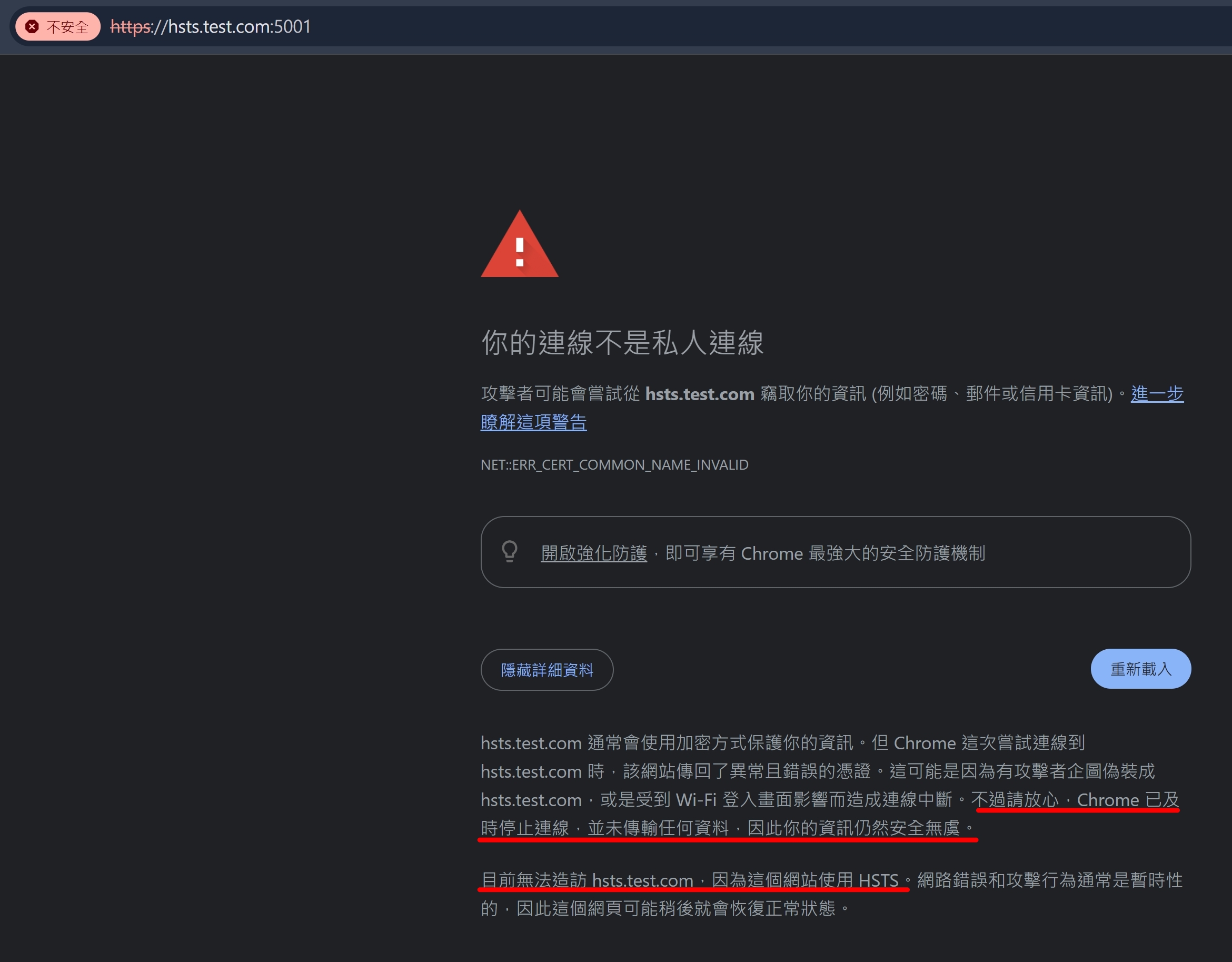 有句話很吸引我的眼球,
有句話很吸引我的眼球,Chrome 已及時停止連線,並未傳輸任何資料,意思是 request 其實根本沒有送出去嗎?我們在 NodeJS HTTPS Server 加個 log 試試看:
httpServer.on("request", function httpRequestListener(req, res) {
console.log("receive request from https server port 5001");
// ...other code
});
重整瀏覽器後,NodeJS 確實沒印出任何 log,瀏覽器在這層的防護是真的很完善!
disable HSTS
根據 MDN文件 的描述:
To disable HSTS, set max-age=0. This only takes effect once the browser makes a secure request and receives the response header. By design, you cannot disable HSTS over insecure HTTP.
我們來實驗看看,先把剛才生成的 private-key.pem 跟 cert.pem 砍掉,然後重新簽憑證
mkcert -key-file private-key.pem -cert-file cert.pem hsts.test.com nodejs.hsts.test.com sub.nodejs.hsts.test.com
調整 NodeJS 程式碼
res.setHeader("Strict-Transport-Security", "max-age=0");
瀏覽器關掉重開,然後 NodeJS 重啟,打開 https://hsts.test.com:5001/
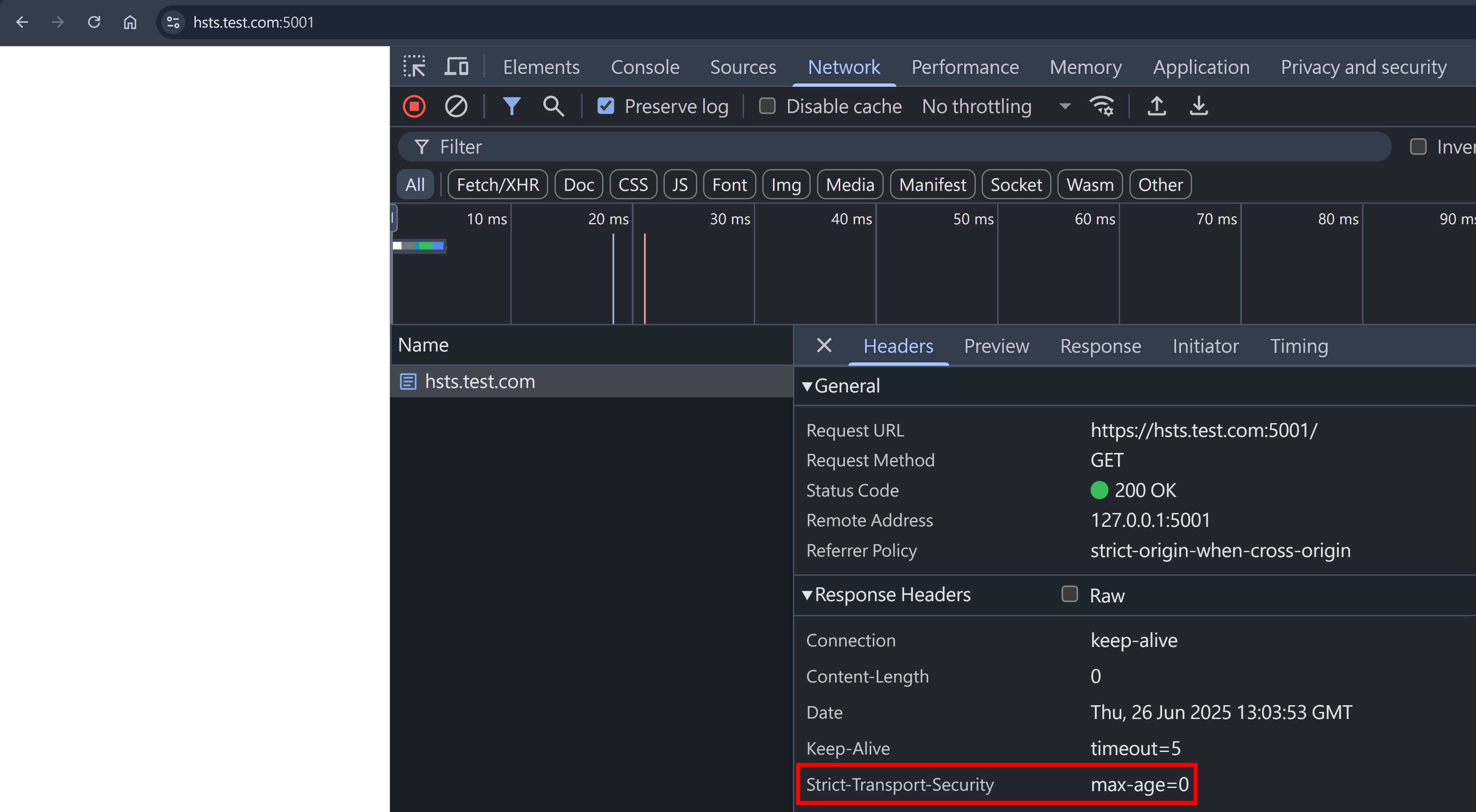 確定有看到
確定有看到 max-age=0 之後,再到 chrome://net-internals/#hsts 查詢
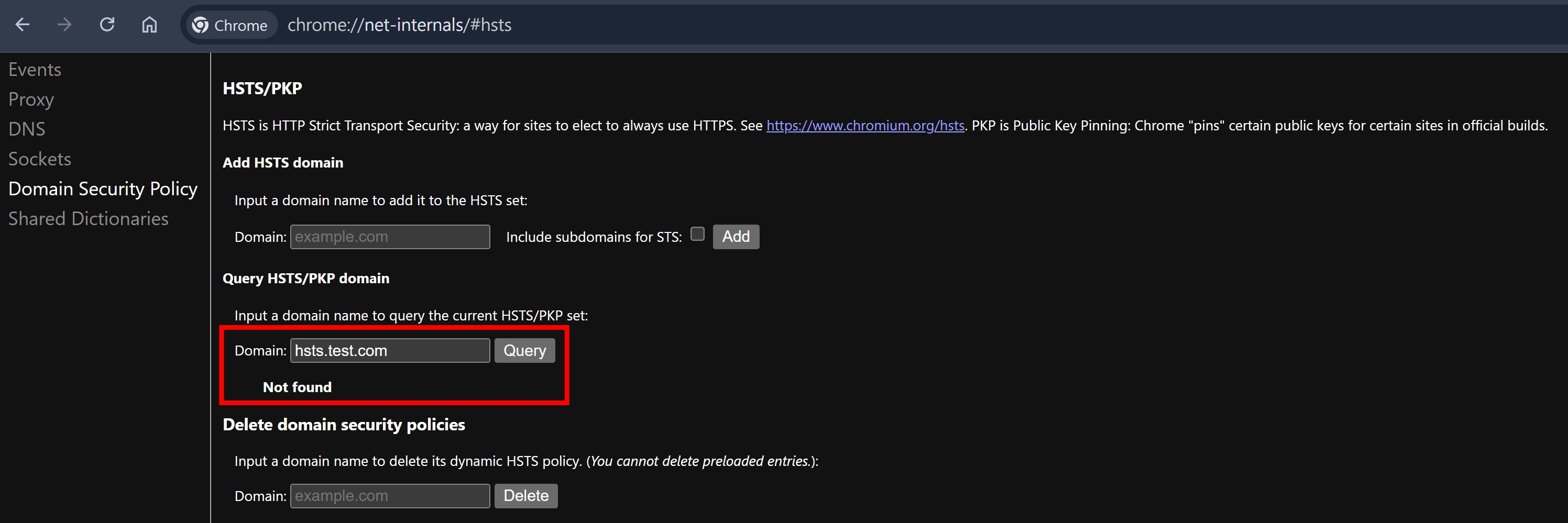 確實刪掉了~
確實刪掉了~
Best Practice
根據 MDN 文件 的描述:
If the host accepts insecure HTTP requests, it should respond with a permanent redirect (such as status code 301) having an https URL in the Location header.
我觀察有一些網站,也確實會 follow 這個 best practice,例如 developer.mozilla.org 就是!且 developer.mozilla.org 也有設定 HSTS。
我們如果要測試上面的情境,需要到 chrome://net-internals/#hsts 先把 developer.mozilla.org 的 HSTS 紀錄刪除,這個步驟就等同於 disable-hsts,只是我們沒辦法碰到 developer.mozilla.org 的 Server,所以才用 chrome://net-internals/#hsts 來刪除。
刪除以後,我們再用瀏覽器輸入 http://developer.mozilla.org/zh-CN/
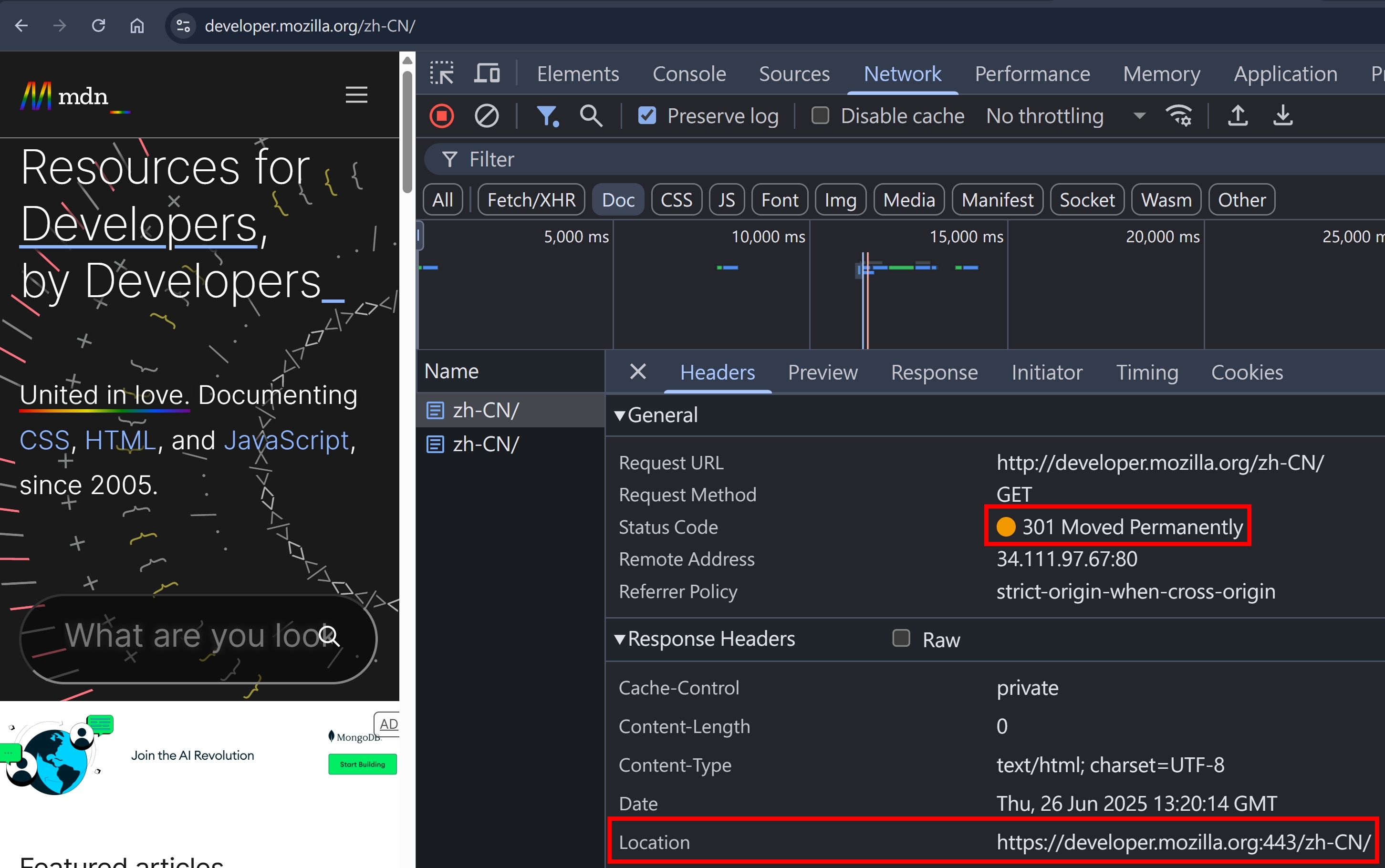 就可以看到 developer.mozilla.org 確實有 Follow Best Practice 了~
就可以看到 developer.mozilla.org 確實有 Follow Best Practice 了~
HSTS 如何強制切到 HTTPS Protocol
我們再次用瀏覽器輸入 http://developer.mozilla.org/zh-CN/ ,由於剛才瀏覽器已經有把 developer.mozilla.org 加到 HSTS 列表,所以 瀏覽器會攔截這個 HTTP Request,並且回傳 307 Redirect 到 HTTPS Protocol,所以對 Server 來說實際上只有收到一個 HTTPS Request,很重要!
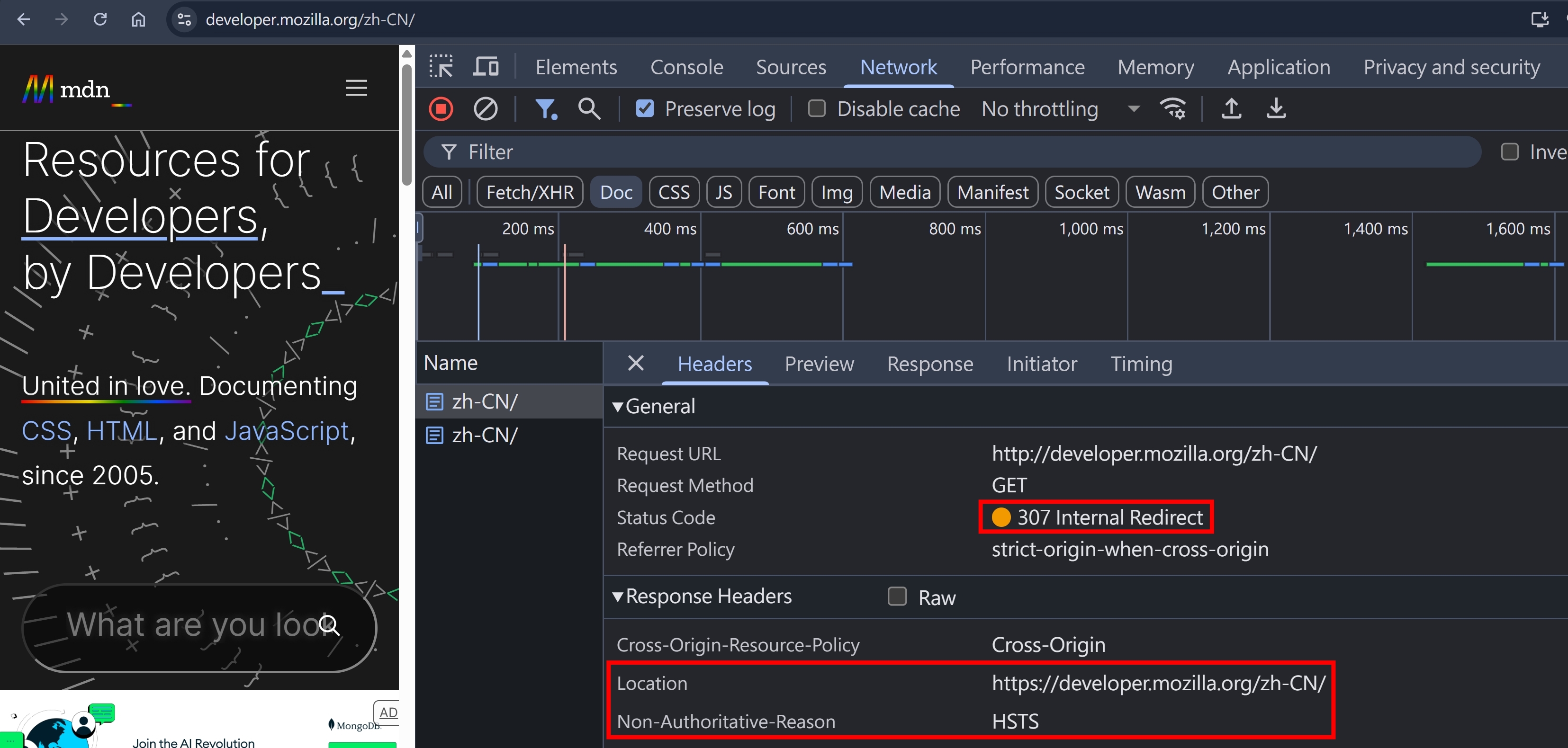 從 Response Header 也可以驗證
從 Response Header 也可以驗證 Server 實際上只有收到一個 HTTPS Request
- 因為上圖的 Response Header 連基本的
Content-Length,Date都沒有,代表這個 HTTP Request 根本沒有到達 Server - 且如果真的有到達 Server 的話,那就失去 HSTS 的意義了,因為 HSTS 就是要避免資料透過 Insecure HTTP 傳輸,瀏覽器的職責就是擋住 HTTP Request,並且轉成 HTTPS
preload 機制
根據 hstspreload.org 的描述:
To account for this first-load problem, Chrome maintains a list of domains that have a strong HSTS policy and are HTTPS only.
簡單來說,我們上面做了那麼多準備,但最終要能夠在瀏覽器註冊 HSTS 列表,還是需要透過 HTTPS 造訪該網站
為了解決這個問題,Chrome 維護了一個 preload list,採取申請制,並且對於申請的規範較為嚴格,且後續要從 preload list 移除也需要再提交申請,整套流程極為複雜,且效益不高(就是為了解決 first-load 的問題),所以申請前請三思!
preload 申請規範
- 合法的憑證(廢話)
- Follow Best Practice
- 所有 subdomain 都要 HTTPS
Strict-Transport-Security: max-age=至少一年; includeSubDomains; preload
小結
HSTS 已經存在 10 幾年了,但我竟然到 2025 年才知道有這個 Security Header,真的是相見恨晚~學習 HTTP 的路程,真的是一路上充滿驚喜,透過這篇文章,我自己也學到很多東西,希望各位也收穫滿滿呦~